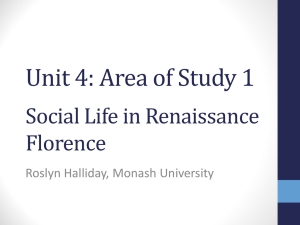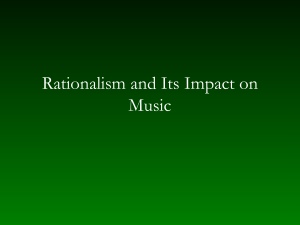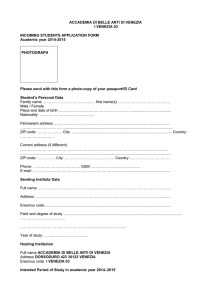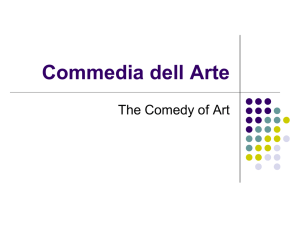The Dual Crises of the Late-Medieval Florentine Cloth Industry, ca
advertisement
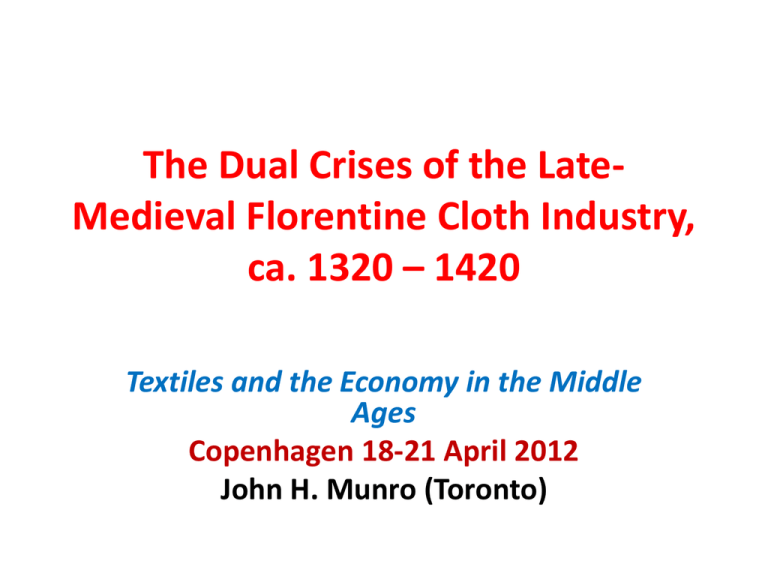
The Dual Crises of the LateMedieval Florentine Cloth Industry, ca. 1320 – 1420 Textiles and the Economy in the Middle Ages Copenhagen 18-21 April 2012 John H. Munro (Toronto) The Dual Crises of the Late-Medieval Florentine Cloth Industry • During the century ca. 1320 – 1420, the Florentine cloth industry underwent two closely connected crises: • (1) first crisis: with beneficial consequences: • made it Italy’s most important manufacturing industry, and a major European leader in producing luxury woollen textiles • (2) second crisis: resulted from the economic conditions that had produced that beneficial outcome of the first crisis: with far longerlasting, deleterious consequences The Florentine Textile Industries and Trade before 1320 - 1 • 1) Arte della Lana: Florentine textile manufacturing industry had largely focused, earlier, on a wide range of relatively low cost, coarse, and lighter fabrics: • - including many worsteds, or hybrid woollenworsteds, and not just cheaper woollens (but also a few costly woollens) • - these were widely marketed throughout the Mediterranean basin (Christian and Muslim lands) – from 12th century The Florentine Textile Industries and Trade before 1320 - 2 • 2) Arte di Calimala: then a far more important guild: more commercial than purely industrial: for luxury quality, heavy-weight woollens • - a) imported such high-quality, high-priced luxury woollens from Champagne Fairs: produced in northern France and Low Countries: known as panni alla francesca • - b) Arte di Calimala: hired specialists to dye, shear, press, and finish these northern woollens • - c) then re-exported these luxury woollens to rest of Italy and Mediterranean basin The First Textile Crisis: Warfare and rising transaction costs (1290s) - 1 • 1) Spreading stain of warfare: from 1290s: • - a) In eastern Mediterranean basin: • - 1291: Mamluk conquest of last Crusader ports in Palestine (Acre) cut vital trades link to western and southern Asia • - 1291-99: Venetian-Genoese wars to control Black Sea trade (alternative trade routes to Asia) • - 1303 & after: Ottoman Turks: invasions of Byzantine Empire SE Europe (Balkans) The First Textile Crisis: Warfare and rising transaction costs (1290s) - 2 • • • • • 1) Spreading stain of warfare: from 1280s: b) Western Mediterranean, NW Europe: - 1282-1302: Wars of the Sicilian Vespers (Italy, France) - 1291-1340: Berber-Merinid invasions of Spain - 1296-1328: Anglo-French, Anglo-Scottish, FrancoFlemish wars & Flemish civil wars • - 1313-43: Guelf-Ghibelline wars in Italy Angevin, Catalan, German, Hungarian invasions of Italy • c) Hundred Years’ War, 1337-1453: involving France, England, Low Countries, and Spain The First Textile Crisis: Warfare and rising transaction costs (1290s) - 3 • 2) Rising transportation & transaction costs • a) disruption of normal trade routes + destruction of commodities, ships, mule-trains, etc: not so much from warfare itself as from breakdown of authority Δ brigandage + piracy Δ civil strife + chronic crime • b) Church & state bans on trade: especially with Mamluks (or all Muslims) costly trade licences when trade temporarily permitted • c) increased taxes & forced loans, coinage debasements (seigniorage profits): for defence, increased military costs• building far larger armed ships: with new artillery The First Textile Crisis: Warfare and rising transaction costs (1290s) - 4 • 3) Major changes in trade + trade routes: from 1290s to the 1320s • a) rapid decline & fall of Champagne Fairs: on which N-S textile trades had been based • b) shift from continental overland trade routes maritime trade routes: • Italy to NW Europe: by 1320s (Venice: 1314) • BUT: from 1332-1400: Venice’s Flanders Galleys made only 24 north-bound voyages The First Textile Crisis: Warfare and rising transaction costs (1290s) - 5 • c) Problems with Italian direct sea routes: • - maritime transport was relatively cheaper (now) than war-torn overland routes; BUT with rising costs • - i) maritime route from Venice/Florence to Southampton & Bruges: 5 times longer than land route • -ii) major problems: naval warfare, increased piracy, ocean storms shipwrecks + destruction • - iii) navigation problems: inability to calculate longitude forced ships to hug coastlines much longer trips • - iv) uncertainty inability to schedule and concentrate international trade transactions in fairs or towns increased transaction costs of trade (over fairs) The Champagne Region (modern) The First Textile Crisis: Warfare and rising transaction costs (1290s) - 6 • 4) Major Economic Consequences by 1320s • a) rising transaction costs of long-distance trade in cheap textiles prohibitive or uneconomic for trade in undifferentiated cheap generic products • producers as ‘price-takers’ unable to raise prices to cover Δ costs (pure competition) • b) Black Death (1348) and depopulation undermined or destroyed scale economies necessary for effective commerce in cheap products: higher transaction costs per unit of goods traded • c) Black Death + ‘Great Depression’ from 1340s more highly skewed distributions of weath, income The First Textile Crisis: Warfare and rising transaction costs (1290s) - 7 • d) strong incentive to shift production + trade to luxury textiles, for which: • i) producers engaged in monopolistic competition based on quality (not so much price) as ‘price-makers’ with more inelastic demand • ii) thus able to raise prices to cover rising transaction costs in long-distance trade • iii) but had to focus on much smaller, wealthier markets – with more inelastic demand The First Textile Crisis: Warfare and rising transaction costs (1290s) - 8 • 4) Major Economic Consequences by 1320s • e) Rapid decline & fall of the Arte di Calimala • - esp. with end of Champagne Fairs: on which its commercial connections were dependent • f) strong incentive for Florentines to develop an import-substitution industry in luxury woollen textiles • g) rapid growth of Arte della Lana from 1320s: in shifting from cheaper textiles to luxury woollens The Golden Age of the Arte della Lana: 1330s to 1370s - 1 • 1) Florence’s Arte della Lana became Italy’s single most important manufacturing industry (esp. textiles) • chief rival of Flemish cloth industry as leading European producer of luxury woollens • increasingly displaced most luxury woollens from Flanders + Brabant in Mediterranean (except: cheaper but still luxury products of Nouvelles Draperies) • 2) Effectively also displaced and usurped former role of Arte di Calamala: to benefit Florentine merchants in international trade Memling: Adoration of the Magi Memling, Madonna & Child (1490) The Golden Age of the Arte della Lana: 1330s to 1370s - 2 • 3) But NOT a complete transition to luxury woollens: • -a) Hoshino: about 75% of total Arte della Lana production was in luxury woollens by 1340s (vs. 30% in late 1320s) greater by 1390s, but never complete • -b) San Martino sector: based totally on English wool • vs. Garbo sector: based on cheaper, non-English wools • -c) Note: Italians had comparative advantage over northern producers in marketing cheaper textiles: with much lower transaction costs in Mediterranean • -d) Domestic Italian markets remained wealthy and important for cheaper textiles: especially in clothing servants of aristocratic and ecclesiastical housholds The Golden Age of the Arte della Lana: 1330s to 1370s - 2 • 4) Conundrum: Arte della Lana as import substitution industry using English wools • a) sine qua non for luxury cloth production was exclusive use of the finest + costliest English wools: in late-medieval Europe: • b) But why was it more economic to import raw wools than finished woollens: when 35% of wool was removed in production process? The Golden Age of the Arte della Lana: 1330s to 1370s - 3 • 4) Conundrum: Arte della Lana as import substitution industry using English wools • c) Answer: Florentine dominance in European banking: • - innovation of bills of exchange banking and their mercantile monopoly on papal tax collections + banking • - i) used papal taxes collected in cash to buy English wools • - ii) remitted the tax proceeds by bills of exchange (without transporting any specie: dangerous even by sea) • -iii) Florentine and Lucchese merchant-banking houses: had served as bankers to English crown (Edward I & II) from 1270s: by 1280s: total Florentine dominance • Italian loans to king granted on security of wool-export customs duties from 1275 (first instituted by Edward I) The Golden Age of the Arte della Lana: 1330s to 1370s - 4 • c) Florentine dominance in European banking: • -iii) Italians (Florentines) displaced the Flemish in dominating English wool exports by late 1270s • -iv) but the Low Countries received almost all of wools that Italians then exported -- before the 1320s • - v) from 1320s-30s, the Italians were shipping English wools chiefly by sea, to Italy • - vi) Florentine merchants profited handsomely from both banking operations and the wool trade • - d) Arte della Lana had no choice but to use English wools: from time it began specializing in luxury cloth production Del Bene firm of Florence • In years 1355 to 1368, the Florentine merchant firm of the Del Bene imported English wools for the Arte della Lana: • 145,985 lb. Florentine = 49,568 kg. • 80% came from the three major regions: • - Cotswolds: 46.03% • - Welsh Marches (Shropshire): 25.73% • - Lincolnshire: Lindseys: 7.29% The Golden Age of the Arte della Lana: 1330s to 1370s - 4 • 5) Florentine Supremacy in Mediterranean Markets: and with increasingly higher cloth prices • a) Pisa: 1354-1371: mean price = 43.55 florins = £6.50 st; highest: 115 fl. = £17.25 st • b) Catalonia: 1390s: mean price = 64.43 florin = £9.67 sterling (Florentine = 27% of total Datini sales) • c) Syria & Egypt: 1390s: 35 - 54 florins = £5.25 - £8.10 ster., • - vs. Flemish woollens: 38.5 florins for Mechelen woollens and 19.2 florins for Wervik woollens (Nouvelles Draperies) • d) Poland in 1390s: Florentine woollens at 32 florins = £4.81 sterling (shorter) vs. 43.5 florins for Bruges woollens and 46.67 florins for Brussels woollens (£7.00 sterling = 280 days’ wages for an Oxford master mason) The Golden Age of the Arte della Lana: 1330s to 1370s - 5 • 6) Other Italian woollen cloth producers • a) Pisa market: in 1354-71 (Italian = 57% of cloth sales) • Tuscany + adjacent (except Florence): Prato, Pisa, Lucca, Bologna, Perugia: woollens with mean value of 20.43 florins • Lombardy: Milan, Como, Monza, Cremona, Brescia, Verona, Padua, Mantua, Vicenza, Treviso: woollens with mean value of 27.55 florins (£4.13 st) • b) Catalan markets: 1394-1410: 2,652 Florentine woollens (mean: 64.43 fl = £9.67 st) vs just 86 woollens from Prato & Genoa: (mean: 30.78 fl = £4.62 st). • - Florentine mean value = 387 days wages Oxford mason • - Prato/Genoa mean value = 185 days wages Oxford mason (average work year = 210 days!) The Second Florentine Textile Crisis: from 1370s - 1 • 1) The English Wool Problem: bitter seeds of decline for the Arte della Lana • a) total + vital dependence of Florentine, Flemish, Brabantine luxury cloth industries on fine English wools exposed them all to English kings’ fiscal exploitation: hostages to English fortunes! • b) Edward III (1337-77) and Richard II (1377-99): financed wars in France by extortionate increases in wool export taxes, • - while controlling wool sales through Calais Staple cartel (established 1363) • or port of Southampton (for Italian exports: from 1377): The Second Florentine Textile Crisis: from 1370s - 2 • c) Edward III’s war-time, borrowing: after the bankruptcy of Florentine firms (Bardi, Peruzzi, Acciaiuoli), 1341 – 45: crown relied more and more on English merchants giving English greater control over wool exports • -d) Increasing wool-export duties for aliens (i.e., greater increases than for denizens: from 1337 to 1405: • alien wool export duties for Italians increased from 14.56s/sack to over £3 (61.19s)/sack: 4.2 fold increase in export taxes (nominal) The Second Florentine Textile Crisis: from 1370s - 3 • - e) English tax burden ROSE with later deflationary fall in wool prices, because export taxes were ‘specific’ • - from a mean of 13.6% per sack value in 1331-35 to 54.0% in 1396-1400 (vs. 47.7% per sack for ‘denizen’ exports) • f) Fine English wool: were single most important determinant of both luxury quality and of cloth prices: • - evidence from Low Countries (1430s) that tax burdened English wools accounted for 65% - 70% of total costs (before dyeing and finishing) The Second Florentine Textile Crisis: from 1370s - 4 • e) consequence: Italian share of (declining) English wool exports fell from 65.61% in 1351-55 (peak) to just 8.43% in 1401-05 • - Italian wool exports fell from mean of 20,581 sacks in 1351-55 to mean of just 960 sacks in 1411-15 (fall of 95.34%): thus virtually excluded from English wool trade • f) Problem: no viable alternative source of fine wools, yet, for the Italian cloth industries: • - Spanish merino wools not suitable & available until 1490s: • - in 1390s: ranked only 4th or 5th in quality & price The Second Florentine Textile Crisis: from 1370s - 3 • 2) Luxury Re-orientation + Economics of the ‘Great Depression’ era: two aspects for Arte della Lana • a) costs of reorientation to luxury production to survive rising transaction costs necessitated focus on very small wealthy segments of a shrinking market • b) BUT benefit A: supplanting the Arte di Calamala • c) benefit B: supplanting most Flemish & Brabantine luxury woollens in Med markets: except those of Flemish nouvelles draperies (eg Wervik) -- cheaper • d) possible benefit C: shift partly sustained by aspects of ‘Great Depression’ more highly skewed distributions of wealth and income The Second Florentine Textile Crisis: from 1370s - 4 • 3) Market Contractions: Warfare, Plague, and ‘Great Depression’ inescapable fall in cloth outputs • a) Demographic contraction in western Europe: from 40% to 50% -- or more? • b) Fall in Florence’s Population: Herlihy, Najemy, Goldthwaite • - Black Death (1348): loss of 70%; but then some demographic recovery • - From 1300- 1400: net loss of 50%+ • - demographic nadir in 1427 (Catasto): only 31% of population for 1300 (i.e., 70% loss) Population of Florence (Tuscany) Date 1300 Estimated Urban Population 120,000 1349 36,000? 1352 41, 600 1390 60,000 1427 37,144 1459 37,369 1469 40,332 1488 42,000 1526 (plague year) 70,000 The Second Florentine Textile Crisis: from 1370s - 5 • 4) Revolt of the Ciompi (1378 – 1382): cause or symbol of decline? • a) revolt of textile artisans against Florence’s Arte della Lana and Signoria (civic gov’t) & Parte Gulfa 3 new guilds, which were finally crushed and disbanded • - more significant as symptom than as cause of Florentine cloth industry’s decline • -b) causes: warfare (War of Eight Saints), rising taxation & forced loans, economic depression, oppressive rule of Arte della Lana over artisans (had been excluded from guilds) • - c) a chief demand of the Ciompi: that the Arte della Lana be compelled to produce 2,000 bolts per month = 24,000 per year • - d) significance: indicates excess labour supply in Florence, despite drastic fall in population • that markets had contracted more than had the industrial labour force The Second Florentine Textile Crisis: from 1370s - 6 • 5) Decline in Arte della Lana’s cloth outputs • a) Villani: decline in total output from about 100,000 bolts in 1300 to 75,000 in 1330s: but that represented shift from cheaper to luxury fabrics (made from English wools): i.e., 1st crisis • b) From: 75,000 bolts in late 1330s to about 9,000 in mid 1420s: a fall of 88% -- far more than fall in European population: • 2nd & irredeemable crisis • c) Florentine cloth industry never regained its former level of output or its golden renown Florentine cloth outputs (bolt=36m) Year Villani Franceschi 1300 100,000 1338 75,000 Goldthwaite 1355-60 49,000 1373 30,000 30,000 1381-82 19,296 19,000 1389 16,482 1390 10,000 1391 13,162 1393 14,026 1395 13,672 1425 9,052 1427 9,750 1430 10,049 1433 8,333 13,000 11,000 Florentine Cloth Industry 1420 – 1520 • 1) Some recovery from the 1430s, based on: • a) production of much lower quality woollens: made from domestic Italian wools: known as ‘matricina’ wools (from Abruzzi region) growth of Garbo sector • b) primarily aimed at Muslim Levant (Mamluks) -importing eastern (Persian) silks in return for woollens • 2) Further Expansion from 1490s: output grew from 17,000 bolts in 1488 to maximum of 21,000 in 1526 • a) from ca. 1490: shift from matricina wools to Spanish merino wools – with new Castilian commercial connections • b) upgrade in quality and prices Florentine Cloth Industry 1420 – 1520 • 3) Third Florentine Textile Crisis: • - a) disruption of trade routes for Persian silks hurt Florence, while Venetians gained from its own trade links • -b) Ottoman conquest of the Mamluk domains in 1517 • - c) Bubonic plague + civic revolt (anti-Medici) in Florence Papal + Imperial armies crushed revolt in 1530 • 4) Venetian cloth industry chief beneficiary: • -a) output grew from mean of 2,416 cloths in 1516-20 to maximum of 23,572 cloths in 1601-05 • b) why did it decline thereafter? yet another story – but essentially because of English competition and role of England’s Levant Company (from 1590s).



